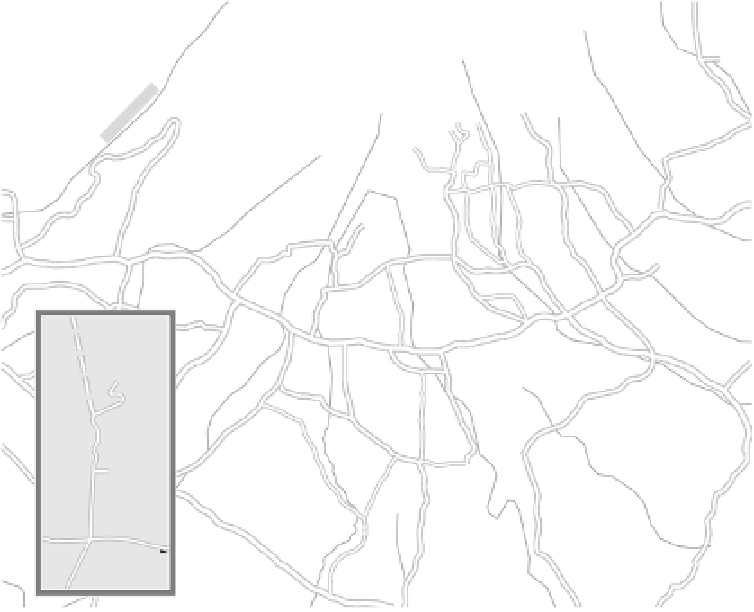Travel Reference
In-Depth Information
Getting There & Around
Buses go from Mandalika to Pomotong
(7000Rp), which is on the main east-west
highway. From there, take a bemo to Kotaraja
(2000Rp), then an
ojek
(3000Rp) or
cidomo
(4000Rp) to Tetebatu.
Bicycles and motorbikes can be rented
at Pondok Tetebatu, and other losmen, for
15,000Rp and 50,000Rp per day, respectively.
SOUTH OF TETEBATU
The nearest market town to Tetebatu is
Ko-
taraja
, which is also the transport hub of the
area. It's known for its skilled blacksmiths.
There's a market on Monday and Wednesday
mornings.
Loyok
is noted for its fine basketry and
Rung-
kang
is known for its pottery, made from a
local black clay. You'll find workshops in
both villages.
Masbagik
is a large town on Lombok's east-
west highway with a daily morning market, a
huge cattle market on Monday afternoon, and
an imposing new mosque with elegant mina-
rets. There's an ATM opposite the mosque.
Masbagik Timur, 1km east, is a centre for
black-clay pottery and ceramic production.
Lendang Nangka
is a Sasak village surrounded
by picturesque countryside, 3km north of the
highway. In and around the village you can
see blacksmiths who make knives, hoes and
other tools using traditional techniques. A few
silversmiths are also based here and there's a
excellent homestay,
Radiah's
(
%
0376 631463; per
person incl meals 50,000Rp)
run by English speaker
Radiah and his wife Sannah, who make Western
CENTRAL LOMBOK
0
8 km
0
4 miles
Taman Nasional
A
B
C
D
Protected
Sapit
Gunung Rinjani
Joben
Forest
Pesugulan
Air Terjun
To Pringgabaya
(8km)
Air Terjun
Jukut
Timbanuh
1
Swela
1
See Enlargement
Sesaot
Tetebatu
Pengadangan
Kembang
Suranadi
Aikmel
3
Waiageseng
To Mataram
Lenek
(10km)
Pringgasela
Kotaraja
Pancordao
Suralaga
Lendang Nangka
Anjani
Kilang
Mantang
Loyok
Rungkang
Masbagik Timor
2
Pomotong
Masbagik
Kopang
0
0
200 m
200 m
Sikur
0
0
0.1 miles
0.1 miles
Terara
Selong
Pancor
Suradadi
5
5
To Taman
Wisata
Tetebatu
To Taman
Wisata
Tetebatu
Sakra
SASAK LIFE
Lombok's indigenous Sasak people comprise about 90% of the island's population. Virtually all
are now orthodox Muslims, though before 1965, many Sasaks in remote areas were Wektu Telu
(see boxed text, p316), a subsect of Islam peculiar to Lombok.
The traditional Sasak village layout is a walled enclosure. Sasak houses are made of bamboo,
and sit on a base of compacted mud; they have a steeply-angled thatched roof, fireplace and
(usually) no windows. A dividing wall of bamboo or woven fibres separates the main living area in
some houses. Each village will have
lumbung,
rice storage barns that sit on stilts (to keep rodents
at bay) that look like little thatched cottages; their façades shaped like the letter omega, or a
mosque's mihrab. (Many hotels in the Gili Islands and Tetebatunow offer
lumbung
-style cottage
accommodation.) There are several examples of traditional villages in northern Lombok including
Dusun Senaru (p312) on the slopes of Gunung Rinjani, while in the south, Sade and Rembitan
(p322) near Kuta also have Sasak houses and
lumbung
. But across the island, modern concrete
homes with tin roofs and windows containing several rooms are becoming more common.
Many Sasak villages, particularly on the north of the island, still maintain a caste system which
heavily influences courtship and marriage - women are not allowed to marry a man from a lower
caste by tradition. Weddings between the highest castes -
Datu
(men) and
Denek Bini
(women) -
and lower castes are quite rare.
There are three kinds of marriage rituals in Sasak culture: arranged marriages, a union between
cousins, and elopement. Until recently, the tradition of elopement was dying out, but with more
contact between castes and travel between villages it has regained popularity. For a boy from a caste
lower than his girlfriend, eloping with her for a specified period of days - whisking her away to a
safe house before notifying the
kepala desa
(village chief ) of his intent to marry her - may be the
only route to marriage. The chief will talk with the couple, negotiate between the parents, consult
elders from both villages, and fix a wedding dowry, and the fine to be paid for the boy's actions.
When romance has been blossoming for a while between a couple, it's not unknown for parents
who disapprove of a daughter's suitor to surreptitiously arrange a marriage with another boy,
confining their daughter to the family home under close supervision. But with many locals now
having access to mobile phones and SMS, boyfriends are often able to 'kidnap' their sweethearts
when she is alone in the family home (strict protocols apply, and for an elopement marriage to be
valid he must take her from her house, not from the village well or by the roadside).
(4km)
(4km)
SIGHTS & ACTIVITIES
Labuhan
Taman Wisata Tetebatu...............
1
C1
Haji
Tetebatu
Tetebatu
4
4
SLEEPING
Cenderawasih Cottages...............
2
A3
Wartel
Wartel
3
Losmen Hakiki..............................
3
C1
6
6
Pondok Tetebatu.........................
4
A3
2
2
Wisma Soedjono..........................
5
A2
To
(4km)
To
(4km)
Kotaraja
Kotaraja
To Losmen
To Losmen
Ojek
Ojek
Stop
Stop
Hakiki
(300m);
Hakiki
(300m);
EATING
Salabuse Café..............................
6
A3
rice fields, about 1km east of the intersection,
this place has charming little
lumbung
with yel-
low window frames and serves tasty Indonesian
and Sasak cuisine (7000Rp to 18,000Rp).
Cendrawasih Cottages
(
%
0818 0372 6709; r
65,000Rp)
Four gorgeous little
lumbung
cot-
tages, with bamboo walls and shower/mandi
facing a pond and garden. Tuck into Sasak,
Indonesian or Western grub (7000Rp to
22,000Rp) in the elevated octagonal lounge
and eating area, which gives sweeping views
of the surrounding area. It's about 500m east
of the intersection.
Wisma Soedjono
(
%
21309; r 75,000-150,000Rp, cot-
tages 125,000Rp;
s
)
About 2km north of the
intersection, these slightly soulless but func-
tional rooms (some with hot water) and lovely
two-storey chalet-style cottages (with both
balconies and verandas) are scattered around
the grounds of a rambling family home. The
large swimming pool is infrequently cleaned
however. There's also a restaurant, with dishes
WATERFALLS
On the southern slopes of Gunung Rinjani
National Park there are two waterfalls. Both
are accessible by private transport, or a lovely
1½-hour walk (one way) through rice fields
from Tetebatu. If walking,
be sure
to hire a
reputable guide (ask at your losmen).
Locals believe that water from
Air Terjun Jukut
(Jeruk Manis, Air Temer; admission 2000Rp)
will increase
hair growth. The falls are a steep 2km walk
from the car park at the end of the road.
Northwest of Tetebatu,
Air Terjun Joben
(Otak
Kokok Gading; admission 2000Rp)
is more of a public
swimming pool, so less alluring.
Sleeping & Eating
Most accommodation in Tetebatu has a rustic
charm. The losmen on Waterfall Rd tend to
be more funky.
Pondok Tetebatu
(
%
632572; s/d 30,000/45,000Rp)
North of the intersection this is a good choice
with two rows of neat, spotless rooms, with








































































